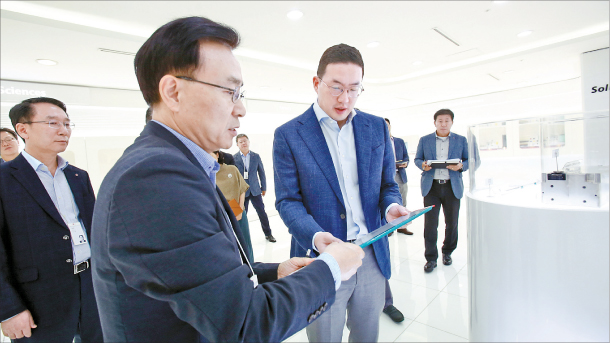LG head calls for more challenging R&D

LG Group Chair Koo Kwang-mo, third from left, learns about LG Chem’s third-generation electric vehicle batteries at the firm’s R&D center in Daejeon on Thursday. [LG GROUP]
The comments came during Koo’s visit to LG Chem’s R&D center in Daejeon on Thursday.
“Obtaining competence in core parts and materials will form the basis of LG’s future products and our growth engine,” Koo told engineers and staff at the R&D center.
He also stressed the importance of concentrating R&D efforts in the right fields.
“We need to look into R&D subjects that are not simply ‘doable’ from a short term perspective, but can really bring innovation to our customer value and align with shifts in customer and market trends.”
Koo’s emphasis on parts and materials comes at a time when national interest in the industry is especially high after Japan enforced export restrictions of such products to Korea. After the measures started to take effect in July, the government and industry watchers have been stressing the importance of dropping Korea’s dependence on Japan for high-tech parts and materials.
In fact, the chairman’s Thursday visit to LG Chem follows an earlier visit last month to LG Electronics’ research center for parts and materials in Pyeongtaek, Gyeonggi.
“LG Chem’s R&D performance will not only strengthen Korea’s competence in parts and materials, but also contribute to stabilizing the supply chain in all relevant industries - we hope all of you take part in R&D activities with pride,” Koo said Thursday at LG Chem.
During the meeting with LG Chem executives, Koo received updated reports on the state of tech development and strategies focusing on three items: third-generation electric vehicle (EV) batteries, soluble organic light-emitting diodes (OLED) and metallocene polyolefin elastomer (POE), a type of plastic.
Third-generation EV batteries provide enough power to run more than 500 kilometers (311 miles) once the car is fully charged. Second generations, on the other hand, offer enough power for 320 to 500 kilometers. Third-generation products are expected to be the norm in the EV industry by 2020, LG said.
Soluble OLED is an advanced method of manufacturing OLED panels. The conventional method of producing an OLED screen is to spread material on the panel and evaporate it under high heat. Soluble OLED screens, however, involve printing material onto the panel using inkjet printing technology, saving materials and costs. LG Chem acquired the technology from U.S.-based DuPont in April.
Metallocene POE is a synthetic plastic material that only five chemical companies in the world have the technology to create, according to LG.
“Metallocene POE has been expanding adoption recently including solar panels,” LG said. “We’re expecting it to enhance our stance in high-value products against Chinese chemical companies that are expanding product portfolios.”
BY SONG KYOUNG-SON [song.kyoungson@joongang.co.kr]










with the Korea JoongAng Daily
To write comments, please log in to one of the accounts.
Standards Board Policy (0/250자)